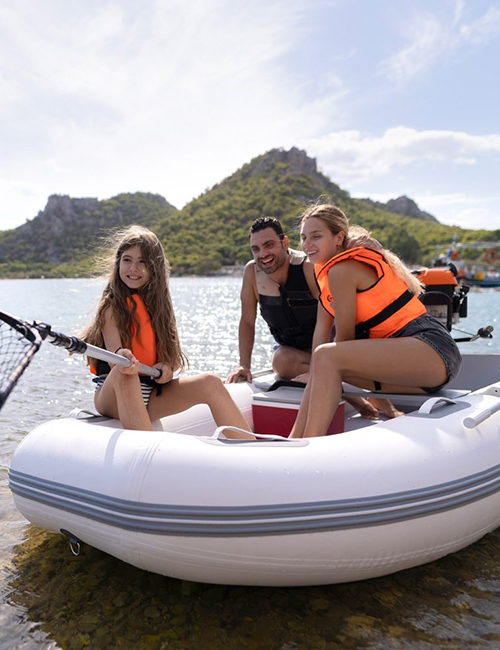


STORAGE
1. After use, the boat and all components should be washed with a mild soap and rinsed with fresh water. Dry all parts before storage in the carrying bag. This will help prevent mould or mildew.
2. Wooden components should be inspected for damage or deterioration to the finish.
Surface scratches or abrasions should be refinished with a marine grade varnish.
3. To keep the boat looking new, store the boat in a cool and dry space and avoid excessive exposure to direct sunlight.
IMPORTANT: Waxes or cleaners containing alcohol SHOULD NOT be used on the boat fabric. Alcohol will prematurely dry out the boat fabric.
4. To avoid damaging the boat during storage, do not place heavy objects on boat.
REPAIR IDEAL CONDITIONS
– Humidity max 60%
– Temperature range between 18 and 25 degrees Celsius
– Repairs should not be carried out in direct sunlight, wind or rain
– Repairs should, however, be undertaken in a well ventilated area
Repair kit contains
– Fabric patches
– Ready-to-use special glue in tube
– Valve spanner
BONDING GUIDE
BONDING PVC
– Colton Inflatables that have tubes constructed with PVC coated fabrics require PVC adhesive (Maxbond 5550). Use only recommended solvent and adhesive.
– Identify the area to be patched. This can be done by running water over the suspect area or spraying or brushing with detergent in water.
– If the hole is only small, cut out a round patch of no less than 60mm diameter. Larger holes or cuts will require proportionately larger patches but always ensure you have at least 30mm of patch around the perimeter of the cut or hole and the corners are well radiused.
– Next hold the patch on the tube and mark out around it.
– Clean both surfaces with solvent and spread a thin layer of adhesive over them.
– When the first coat is dry to the touch (about 10 to 15 minutes) apply a second thin coat. After waiting 5 or 6 minutes, touch the adhesive with the back of your hand. If it no longer appears wet, heat both areas with a hot air gun to re-activate the glue and join the patch to the tube and then clamp or roll the surfaces together. For the best adhesion, roll over the patch with a 3/16th width roller or over the bottom edge of a bottle.
– Do not inflate the boat fully for 24 hours.
– For large tears or cuts a polyurethane adhesive should be used and is best applied by a professional repairer.
BONDING HYPALON
– Colton Inflatables that have tubes constructed with Hypalon coated fabrics cannot be bonded with plastic adhesives or by welding. Only the special adhesives supplied and the following procedures must be used if repairs are to carried out successfully.
– Only use the enclosed adhesive and recommended solvent and catalyst. (In this case MEK solvent is recommended)
– Identify the area to be patched. This can be done by running water over the suspect area or spraying or brushing with detergent in water.
– If the hole is only small, cut out a round patch of no less than 60mm diameter. Larger holes or cuts will require proportionately larger patches but always ensure you have at least 30mm of patch around the cut or hole and the corners are well radiused.
– Next hold the patch on the tube and mark out around it.
– Using a grinder, course sand paper or scratch stone, rough up both the back of the patch and the area marked on the tube.
– Clean both surfaces with solvent and spread a thin layer of adhesive over them ensuring there are no lumps.
– When the first coat is dry to the touch (about 10 to 15 minutes) apply a second thin coat. After waiting 5 or 6 minutes, touch the adhesive with the back of your hand. If it no longer appears wet, heat both areas with a hot air gun to re-activate the glue and join the patch to the tube and then clamp or roll the surfaces together. For the best adhesion, roll over the patch with a 3/16th width roller or over the bottom edge of a bottle.
– Do not inflate the boat fully for 24 hours.
– For large tears or cuts a two part neoprene adhesive should be used and is best applied by a professional repairer.

 Qingdao Colton Yacht Co.,Ltd Factory address: Developed zone, Laixi District, Qingdao,China Office address: Baoli building,Jinshui road, Licang district, Qingdao,China
Qingdao Colton Yacht Co.,Ltd Factory address: Developed zone, Laixi District, Qingdao,China Office address: Baoli building,Jinshui road, Licang district, Qingdao,China +8615165275783
+8615165275783 sales@coltonyacht.com
sales@coltonyacht.com IPv6 network supported
IPv6 network supported


